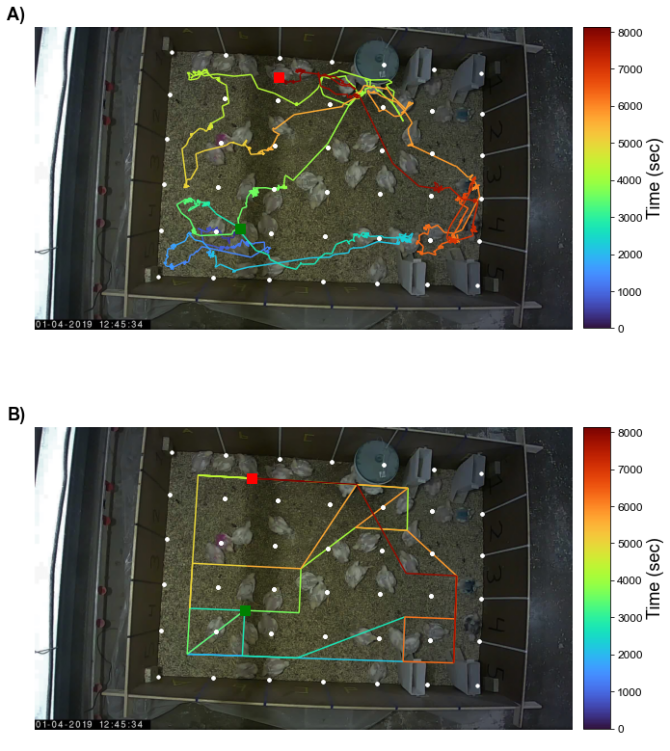
Feathered Features – Phenotyping Poultry with Sensors
WIAS Magazine - Fall edition 2023
Research Highlight
Keywords: Sensors, broilers, tracking, activity, behaviour
Phenotyping individual animals is an important step in breeding programs to select for specific traits. However, phenotyping can become difficult and time-consuming for traits related to health, welfare, and performance. Activity is one potential phenotype associated with an animal’s health, welfare, and performance. Understanding an animal’s activity can provide valuable insights into various aspects, including sickness behaviour [1], leg problems [2], and their growth [3]. Therefore, animal location and movement could be a proxy for these traits if we can record them automatically and reliably on many animals.
In the paper we explored two methods to follow our broilers: a passive radio frequency identification (RFID) system and video tracking. The RFID-system uses a grid of antennas to track the chickens, or rather their RFID-tag, while video tracking uses computer vision to detect and track the animals. Finding and following your broilers on video is not easy, so we colour-marked three of our broilers to make it easier.
Our results showed that the two methods largely agree on the location of the chickens. Most location differences (95.3%) were within a one antenna distance (≤ 56.30 cm). The RFID-system did not always register the movement of the animal, but video tracking was sensitive to detection noise and the animal’s behaviour. An example of the recorded locations and movement of one of the animals for each method is shown in Figure 1.

Figure 1. Location of one of the broilers over time as derived from video tracking (A) and the RFID-system (B). The green square represents the track’s start, and the red square represents the track’s end. The colour transition depicts the location’s progression from dark blue to dark red over time. The white dots represent the antenna corners. The plot is projected over a darkened video freeze frame.
An animal’s location and its movement also provide us with data that can be used to gather information on various behavioural metrics and indirectly also understand their environment, such as their feeding and drinking behaviour and how they utilize space. This information presents opportunities for improving the precision of breeding, feeding, and managing broilers. Regarding the measurement of behavioural metrics, it is worth noting that video tracking typically offers a higher accuracy compared to the RFID-system. However, it is important to acknowledge that the RFID-system can provide reasonably accurate approximations of these behavioural metrics.
The RFID-system has the advantage of providing individual identification for non-colour marked broilers, which video tracking cannot do. On the other hand, video tracking provides detailed information on the chicken’s behaviour. A combination of the two methods could provide a better understanding of the broiler’s behaviour. The unique identification of the RFID-system combined with the detailed information of video tracking could allow us to record a wide range of individual broiler behaviours.
Phenotyping individual animals can be a challenge, but new technologies such as RFID-systems and video tracking could make it easier and more efficient. By combining the strengths of both methods, we can gain a better understanding of our broilers and make more informed decisions in a breeding program.
Results of the study were published in Poultry Science.
[1] Hart BL. Biological basis of the behavior of sick animals. Neurosci Biobehav Rev 1988;12:123–37. https://doi.org/10.1016/S0195-5616(91)50028-0.
[2] Tahamtani FM, Hinrichsen LK, Riber AB. Welfare assessment of conventional and organic broilers in Denmark, with emphasis on leg health. Veterinary Record 2018;183:192. https://doi.org/10.1136/vr.104817.
[3] Tickle PG, Hutchinson JR, Codd JR. Energy allocation and behaviour in the growing broiler chicken. Sci Rep 2018;8:1–13. https://doi.org/10.1038/s41598-018-22604-2.





